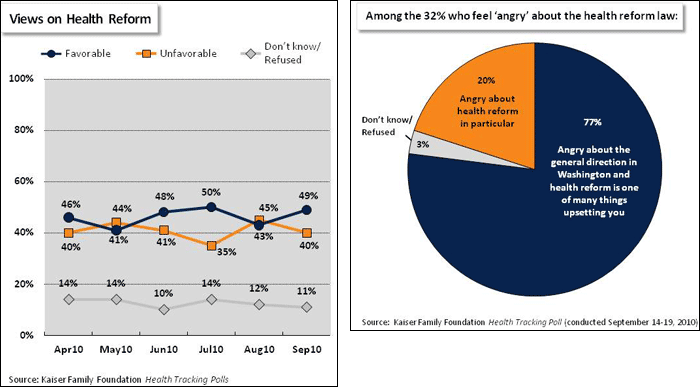Pulling it Together: Health Reform’s Six-Month Checkup
Six months after its enactment, there are two totally different stories to tell about the health-reform law. The public remains split on the law largely along traditional partisan lines. Confusion and misperception are rampant, with more than a third of seniors still thinking the law contains “death panels” (it does not). Yet beneath the political battle lies a success story of early implementation: The federal government that many regard as sluggish and ineffective has turned major elements of the legislation into reality right on schedule.
Since the bill’s passage, the Department of Health and Human Services has set up a program to help people with preexisting health conditions get coverage through state or federal high-risk pools; established a program to help employers provide health insurance to early retirees; issued rebates to help pay drug costs for Medicare beneficiaries stuck in the “doughnut hole”; provided tax credits to small businesses to provide insurance coverage; and created a consumer-friendly Web site, http://HealthCare.gov, that rivals anything coming out of Silicon Valley (where our organization is based).
Several popular provisions take effect Thursday. They include allowing adult children up to age 26 to be on their parents’ insurance; banning lifetime benefits caps and loosening annual limits on insurance coverage payouts; prohibiting insurance companies from kicking people off of their policies when they get sick; and requiring that newly purchased insurance policies cover preventive services at no cost to patients.
Still, our monthly polling finds the public split on the law, with 49 percent in favor vs. 40 percent against in September and the rest undecided. Public sentiment about health reform has shifted within a narrow band since the spring, with slightly more in favor in some months and slightly more against in others. For many who oppose it, the law reflects deeper discontent. When we asked people who said they were angry about the law why they were angry, the vast majority reported that, more than being upset with the law itself, they were angry about the general direction in Washington. Meanwhile, with a few notable exceptions — such as requiring that people have insurance — the law’s major provisions appear to be very popular with the public.

The provisions that will touch the most people — an expansion of Medicaid, new insurance marketplaces in every state, tax subsidies for working people without insurance, guaranteed access to insurance and the hotly debated requirement that almost everybody purchase coverage — do not come until 2014. And eventually, real-world experience with these changes will trump political argument when the public renders its verdict on the law.
The government has made substantial progress already in implementing reform this year, including many measures popular with the public…
- No pre-existing condition exclusions for children (72% favorable)
- Extend dependent coverage to age 26 (53% favorable)
- No out-of-pocket costs for preventative services (70% favorable)
- No cancellation of coverage except for fraud (68% favorable)
- High risk pool for people with pre-existing conditions (61% favorable)
- Small business health insurance tax credits (71% favorable)
- Drug rebates for Medicare beneficiaries (64% favorable)
...but major elements of the law that will affect many more people don’t kick in until 2014.
- Guaranteed access to insurance regardless of your health(69% favorable)
-
Insurance exchanges to make it easier to buy coverage (87% favorable)
- Tax credits to make insurance more affordable for low and middle income people (76% favorable)
- Expanded Medicaid coverage for low income people(71% favorable)
- A requirement that people have insurance (70% UNfavorable)
- Penalties for employers that don’t offer coverage to workers (51% favorable, 47% unfavorable)
Consider what happened when a Republican-controlled Congress created the Medicare drug benefit in 2004. Three times as many seniors opposed the law as favored it, and many liberals criticized the legislation as a first step toward privatization of Medicare, just as some conservatives call current health reform a government takeover. Within three years, though, supporters of Medicare Part D outnumbered detractors as it became clear the program was working well and helping seniors afford their medicines. The new health-reform law represents a much bigger change than the Medicare drug benefit was and may work out differently, especially if Republicans succeed in their efforts to block full implementation. But if the reform continues on pace, as happened with Part D, the law’s fate will be determined not by the early political debate but by how people believe the law is working for them and their families and friends once its major elements are implemented.
At the six-month mark, the politics of health reform remain as ugly as ever, but implementation of the law’s benefits and changes has been a success story so far. There is a lot of heavy lifting still to come.
